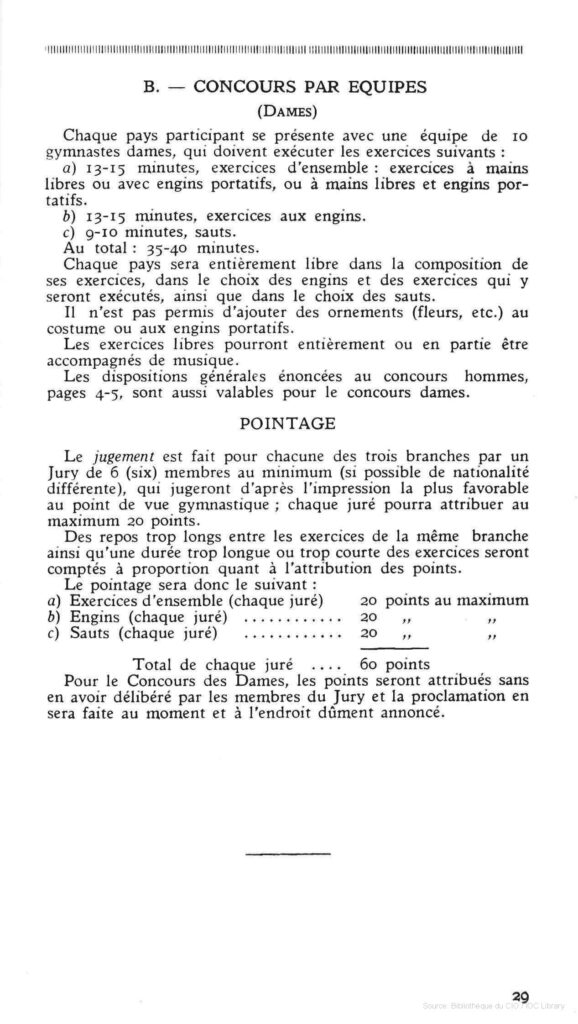In 1928, women finally competed in gymnastics at the Olympic Games. Previously, they had been allowed to perform exhibitions, but they weren’t part of the competitive program.
The rules for the women’s competition at the 1928 Olympic Games were vague at best. After reading this post, you’ll probably have more questions than answers.
So, here are the rules…

THE PROGRAM
A team of 12 female gymnasts per nation, where only 10 take part in a team competition, without individual ranking.
TEAM COMPETITION
(Women)
Each participating country will present a team of 10 female gymnasts, who should execute the following exercises:
13-15 minutes: ensemble exercises: exercises with or without portable hand apparatus, or exercises with and without portable hand apparatus [the Official Report translated it as “drills”]
13-15 minutes: exercises with apparatus
9-10 minutes: vaults [the Official Report translated it as “jumps”]
In total: 35-40 minutes
Each country will be entirely free in the composition of its exercises, in the choice of the apparatus, and the exercises which will be executed, as well as in the choice of vaults.
It is not allowed to add ornaments (flowers, etc.) to the uniforms or portable hand apparatus.
The ensemble floor exercises may be entirely or partly accompanied by music.
The general provisions set out in the men’s competition, pages 4-5, are also valid for the women’s competition.
Note: This is very open-ended compared to the 1925 Workers’ Olympics, during which the women had very specific events that they competed on, including compulsory routines.
SCORING
Judgment is made for each of the three branches [i.e. drill, apparatus, and vault] by a Jury of at least 6 (six) members (if possible of nationality different), who will judge according to the most favorable impression from a gymnastic point of view; each juror may assign up to the maximum 20 points.
Too long rests between exercises of the same branch as well as a too long or too short duration of the exercises will be counted in proportion to the allocation of points.
The score will therefore be as follows:
Ensemble exercises (each judge) = 20 points maximum
Apparatus (each judge) = 20 points maximum
Vaults (each judge) = 20 points maximum
Total of each judge = 60 points
For the Women’s Competition, points will be awarded without having deliberated on it by the members of the Jury, and the proclamation will be made at the time and place duly announced.
The Applicable Men’s Rules from Pages 4-5
The rules noted that certain men’s rules were applicable to the women, as well. Here they are:
Each competing team will be under the direction of a non-ranking director, throughout the duration of the events. The duties of the Director will be limited to leading the section before the Jury and from one event to another; he will be able to show the ensemble exercises, on one side, and will direct them. Before the execution of the routines, the Director must check that the apparatus are in good condition; during the execution, he must stand close to the apparatus to possibly prevent an accident, but cannot help in performing an exercise. His names and title will be mentioned on the list of names of the gymnasts forming the section. His work is neither evaluated nor scored. He will be the intermediary between the Jury and team.
The order of the competing teams will be indicated by the drawing of lots.
A schedule will be established, according to which the groups will line up for the competitions.
At the time indicated for the beginning of the events, all the members of the Jury and the competing teams must be on the ground at the designated locations.
Groups arrive and depart altogether.
Members of the jury are obliged to be at their events and cannot accept functions that could distance them from the field of play and thus hinder the regular progress of the competition.
Any gymnast leaving his team without authorization from the Jury can’t return.
It is not permitted during the course of events to substitute one gymnast for another.
Gymnasts must take into account the observations of the Jury.
Any indisposition, any accident, must be immediately reported by the Director and observed by the doctor on duty.
In order to allow the indisposed gymnast to recover, he or his team may interrupt his work for twenty minutes at most. If, after this period of time, the incapacity observed persists, the team will resume work, and the gymnast will be eliminated.
Any complaint concerning the participation of a gymnast must be made at the start of the competition, or as soon as the cause arises.
Competition attire must be uniform for all gymnasts of a team; members of the same team will wear a common distinctive insignia. Gymnasts specifically cannot take off their shoes.
The field for the events will be fully isolated and accessible only to members of the Jury, gymnasts, and Directors of the competing teams.
As I said, you’ll probably have more questions than answers. For example, what equipment did they use during the apparatus portion of the competition?
We’ll find out in our next post…